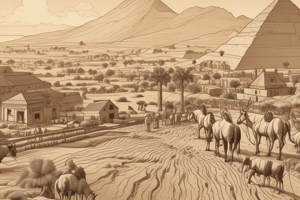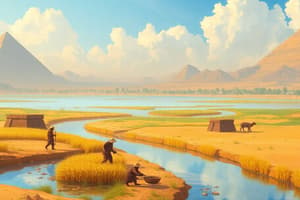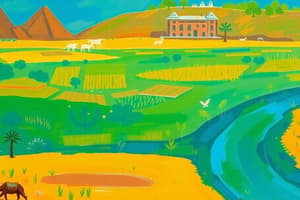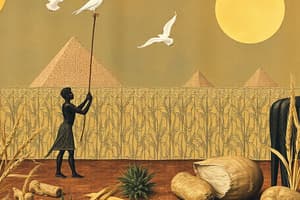Podcast
Questions and Answers
What was essential to Egyptian life in addition to the irrigation canals?
What was essential to Egyptian life in addition to the irrigation canals?
- Fertilizers
- Crop rotation
- The yearly inundation of the Nile (correct)
- Planting techniques
The Hyksos introduced new irrigation techniques during the Second Intermediate Period.
The Hyksos introduced new irrigation techniques during the Second Intermediate Period.
True (A)
What device did ancient Egyptians use to help lift water for irrigation?
What device did ancient Egyptians use to help lift water for irrigation?
Shadoof
Egyptians improved upon irrigation techniques through the expanded use of ______.
Egyptians improved upon irrigation techniques through the expanded use of ______.
Match the following irrigation concepts with their descriptions:
Match the following irrigation concepts with their descriptions:
Which of the following best describes the purpose of irrigation canals?
Which of the following best describes the purpose of irrigation canals?
Wooden models of tools used for ploughing were primarily made for decorative purposes.
Wooden models of tools used for ploughing were primarily made for decorative purposes.
What role did livestock play in the planting process described?
What role did livestock play in the planting process described?
Which of the following crops were among the four main types in the Greek world?
Which of the following crops were among the four main types in the Greek world?
Sickles in ancient Greece were primarily used for ploughing fields.
Sickles in ancient Greece were primarily used for ploughing fields.
What material did Greek architects prefer for public buildings?
What material did Greek architects prefer for public buildings?
Greek agricultural equipment was primarily made out of wood or _____ tipped ploughs.
Greek agricultural equipment was primarily made out of wood or _____ tipped ploughs.
Match the agricultural equipment with their uses:
Match the agricultural equipment with their uses:
What type of roof was commonly used on early 8th century BCE temples?
What type of roof was commonly used on early 8th century BCE temples?
Livestock was used in the threshing process by trampling on the harvested grains.
Livestock was used in the threshing process by trampling on the harvested grains.
Name two fruits grown by private households in the Greek world.
Name two fruits grown by private households in the Greek world.
What significant development happened in Tell Abu Hureyra around 9,700 BCE?
What significant development happened in Tell Abu Hureyra around 9,700 BCE?
Nineveh was one of the earliest Mesopotamian cities established by 6,000 B.C.
Nineveh was one of the earliest Mesopotamian cities established by 6,000 B.C.
What civilization arose in the lower Tigris-Euphrates valley around 5,000 B.C.?
What civilization arose in the lower Tigris-Euphrates valley around 5,000 B.C.?
The ______ people were notable for their development of farming and cattle raising.
The ______ people were notable for their development of farming and cattle raising.
Match the following ancient Mesopotamian cities with their characteristics:
Match the following ancient Mesopotamian cities with their characteristics:
Which of the following was NOT developed by ancient Mesopotamian societies?
Which of the following was NOT developed by ancient Mesopotamian societies?
The Sumerians were the first to develop a system of writing.
The Sumerians were the first to develop a system of writing.
Name two city-states that were part of the Sumerian civilization.
Name two city-states that were part of the Sumerian civilization.
What was the primary function of a nilometer?
What was the primary function of a nilometer?
The shadoof was an ancient Egyptian device used to lower water into the Nile.
The shadoof was an ancient Egyptian device used to lower water into the Nile.
During which two dates does the sun illuminate the sanctuary of the Abu Simbel temple?
During which two dates does the sun illuminate the sanctuary of the Abu Simbel temple?
The ______ system was used by ancient Egyptians to irrigate their crops by raising water with oxen.
The ______ system was used by ancient Egyptians to irrigate their crops by raising water with oxen.
Match the following ancient Egyptian inventions with their purposes:
Match the following ancient Egyptian inventions with their purposes:
What construction achievement is Rameses II known for?
What construction achievement is Rameses II known for?
What innovative technique did Sumerian metallurgists use to control furnace temperatures?
What innovative technique did Sumerian metallurgists use to control furnace temperatures?
Nilometers were only located on one specific part of the Nile River.
Nilometers were only located on one specific part of the Nile River.
The Sumerians were the first to develop a formal numbering system based on units of 10.
The Sumerians were the first to develop a formal numbering system based on units of 10.
What materials did the Sumerians use to create their cuneiform script?
What materials did the Sumerians use to create their cuneiform script?
What kind of precision was exemplified in Egypt's temples?
What kind of precision was exemplified in Egypt's temples?
The Akkadian empire is thought to be the first dynastic rulership established in _______.
The Akkadian empire is thought to be the first dynastic rulership established in _______.
What was one of the achievements of the Akkadian kings in administration?
What was one of the achievements of the Akkadian kings in administration?
Match the following civilizations with their contributions:
Match the following civilizations with their contributions:
The Akkadian Empire was able to maintain complete control over its territories without any uprisings.
The Akkadian Empire was able to maintain complete control over its territories without any uprisings.
Which areas were part of the Akkadian Empire's expansion?
Which areas were part of the Akkadian Empire's expansion?
Who is credited with building the Hanging Gardens of Babylon?
Who is credited with building the Hanging Gardens of Babylon?
Ancient Egypt was known for its technological advancements in engineering and construction.
Ancient Egypt was known for its technological advancements in engineering and construction.
What civilization was considered preeminent in the Mediterranean world for almost 30 centuries?
What civilization was considered preeminent in the Mediterranean world for almost 30 centuries?
The main sources of information about ancient Egypt are many monuments, objects, and artifacts covered with ______.
The main sources of information about ancient Egypt are many monuments, objects, and artifacts covered with ______.
Match the following aspects of ancient Egypt with their descriptions:
Match the following aspects of ancient Egypt with their descriptions:
What field of study has been created due to the interest in ancient Egypt?
What field of study has been created due to the interest in ancient Egypt?
The Hanging Gardens of Babylon are believed to be located in Egypt.
The Hanging Gardens of Babylon are believed to be located in Egypt.
What is the time span of ancient Egyptian civilization mentioned in the content?
What is the time span of ancient Egyptian civilization mentioned in the content?
Flashcards
Cuneiform script
Cuneiform script
A method of writing using wedge-shaped marks on clay tablets.
Sumerian numbering system
Sumerian numbering system
The first formal numbering system based on units of 60.
Akkadian Empire
Akkadian Empire
The first dynastic rulership in history, known for uniting Mesopotamia.
Year name system
Year name system
Signup and view all the flashcards
Unified weights and measures
Unified weights and measures
Signup and view all the flashcards
Hereditary monarchy
Hereditary monarchy
Signup and view all the flashcards
Sumerian metallurgy
Sumerian metallurgy
Signup and view all the flashcards
Bellows
Bellows
Signup and view all the flashcards
Tell Abu Hureyra
Tell Abu Hureyra
Signup and view all the flashcards
The shift to agriculture at Tell Abu Hureyra
The shift to agriculture at Tell Abu Hureyra
Signup and view all the flashcards
Nineveh
Nineveh
Signup and view all the flashcards
Sumerian civilization
Sumerian civilization
Signup and view all the flashcards
Irrigation and aqueducts in Sumer
Irrigation and aqueducts in Sumer
Signup and view all the flashcards
Sumerian cities
Sumerian cities
Signup and view all the flashcards
The Ubaid people
The Ubaid people
Signup and view all the flashcards
Uruk
Uruk
Signup and view all the flashcards
Irrigation
Irrigation
Signup and view all the flashcards
Irrigation canals
Irrigation canals
Signup and view all the flashcards
Inundation
Inundation
Signup and view all the flashcards
Shadoof
Shadoof
Signup and view all the flashcards
Water wheels
Water wheels
Signup and view all the flashcards
Nile silt
Nile silt
Signup and view all the flashcards
Farming techniques in ancient Egypt
Farming techniques in ancient Egypt
Signup and view all the flashcards
Sowing
Sowing
Signup and view all the flashcards
Ancient Egyptian Irrigation System
Ancient Egyptian Irrigation System
Signup and view all the flashcards
Why are the Hanging Gardens of Babylon the most captivating wonder?
Why are the Hanging Gardens of Babylon the most captivating wonder?
Signup and view all the flashcards
Nilometer
Nilometer
Signup and view all the flashcards
Where and who built the Hanging Gardens of Babylon?
Where and who built the Hanging Gardens of Babylon?
Signup and view all the flashcards
How long did Ancient Egypt remain a leading civilization?
How long did Ancient Egypt remain a leading civilization?
Signup and view all the flashcards
Nilometer Network
Nilometer Network
Signup and view all the flashcards
What aspects of Ancient Egypt inspire ongoing research?
What aspects of Ancient Egypt inspire ongoing research?
Signup and view all the flashcards
Abu Simbel
Abu Simbel
Signup and view all the flashcards
How do we learn about Ancient Egypt?
How do we learn about Ancient Egypt?
Signup and view all the flashcards
Abu Simbel's Sun Alignment
Abu Simbel's Sun Alignment
Signup and view all the flashcards
Precision in Egyptian Temple Design
Precision in Egyptian Temple Design
Signup and view all the flashcards
What are Ancient Egypt's notable features?
What are Ancient Egypt's notable features?
Signup and view all the flashcards
Amun
Amun
Signup and view all the flashcards
How was engineering skill evident in Ancient Egypt?
How was engineering skill evident in Ancient Egypt?
Signup and view all the flashcards
What did ancient Egyptian technology influence?
What did ancient Egyptian technology influence?
Signup and view all the flashcards
What were the 4 main crops in ancient Greece?
What were the 4 main crops in ancient Greece?
Signup and view all the flashcards
What tools did ancient Greek farmers use?
What tools did ancient Greek farmers use?
Signup and view all the flashcards
How did wealthier farmers improve their farming efficiency?
How did wealthier farmers improve their farming efficiency?
Signup and view all the flashcards
How did ancient Greeks extract grape juice for wine making?
How did ancient Greeks extract grape juice for wine making?
Signup and view all the flashcards
How did ancient Greeks extract olive oil?
How did ancient Greeks extract olive oil?
Signup and view all the flashcards
What were the key principles of Greek architecture?
What were the key principles of Greek architecture?
Signup and view all the flashcards
What were the primary building materials in ancient Greece?
What were the primary building materials in ancient Greece?
Signup and view all the flashcards
How did Greek architecture influence later architectural styles?
How did Greek architecture influence later architectural styles?
Signup and view all the flashcards
Study Notes
Development of Science & Technology Throughout History
- Learning Outcomes: Students will identify significant technological discoveries impacting human life and communities throughout ancient, medieval, Renaissance, and modern times.
- Timeline of Human Development: Includes key stages of human evolution, highlighting Homo habilis (skillful human), Homo erectus (upright human), Homo sapiens (wise human), and Homo sapiens sapiens (modern human).
- Early Technology: The Stone Age (2.5 mya - 3000 BC) is divided into Paleolithic, Mesolithic, and Neolithic periods. Technological advancements in tool-making progressed through these periods, leading to a shift from hunter-gatherer to farming cultures.
- Paleolithic Period (2.5 mya–10,000 BC): Early humans lived in caves or simple shelters, were hunters and gatherers, utilizing basic stone and bone tools. They used fire for cooking and warmth.
- Mesolithic Period (10,000 BC – 8,000 BC): Humans used smaller, polished stone tools, often living near water sources, and agriculture was introduced.
- Neolithic Period (8,000 BC – 3,000 BC): Ancient humans transitioned from hunters and gatherers to agricultural production. Polished tools, like hand axes, became common. Settling and farming developed.
- Stone Age Breakthroughs in Hunter-Gatherer Tools: Details various stone tools, their characteristics, and timelines. Includes Oldowan tools (2.6 million years ago) and Acheulean handaxes (1.6 million years ago).
- New kinds of knapping (Levallois technique): 400,000 to 200,000 years ago; This involved carefully shaping stone cores to produce sharp flakes.
- Cutting blades (Aurignacian industry): 80,000 to 40,000 years ago; Involved creating long, rectangular blades from stone.
- Small, sharp micro blades (Magdalenian culture): 11,000 to 17,000 years ago; Characterized by geometric microliths.
- Axes, celts, chisels (Neolithic tools): 12,000 years ago; These tools helped humans clear land for agriculture.
The Bronze Age (3000 BC to 1300 BC)
- Metalworking advances using bronze (copper and tin alloy) replaced earlier stone tools and weapons.
- Innovations included ox-drawn plows and the wheel.
- Village life and settlements further developed.
The Fertile Crescent
- Geographic region in the Middle East.
- Cradle of civilization, with early agricultural and urban development.
- Regions were home to the earliest civilizations - Sumerians, Babylonians, Assyrians, Egyptians and Phoenicians.
Mesopotamian Civilization
- Geographic area between the Tigris and Euphrates rivers.
- Home to some of the earliest human civilizations.
- Includes circular dwellings made of mud and brick, along with agricultural practices.
- Domesticated animals and early plants were prevalent.
- First known use of irrigation.
Sumerian Civilization
- Developed in Mesopotamia.
- Notable for its achievements, including: Mass-produced pottery through the potter's wheel, writing systems (cuneiform), hydraulic engineering, the chariot and the plow.
- Created early cities and administrative structures.
Akkadian Empire
- First unified empire in Mesopotamia.
- Created administrative firsts like systems of weights and measures.
- Faced frequent uprisings.
The Assyrians
- Expanded Mesopotamian territory.
- Became a powerful empire, known for their sophisticated military and bureaucratic systems.
- Developed advanced agricultural technologies.
Assyrian Contributions: Agricultural Technology
- Extensive canal systems to manage floods and irrigation.
Babylonian Civilization
- Significant contributions in mathematics.
- Developed a code of laws.
- Known for architectural innovations, such as arches and the dome.
Babylonian Mathematical Techniques
- Cuneiform script for writing.
- Utilized a sexagesimal system.
- Significant discoveries in mathematics, such as quadratic and cubic equations, fractions and the Pythagorean theorem.
Babylonian Architecture and Art
- Utilized adobe and molded bricks.
- Developed arches and domes, particularly in palaces.
The Hanging Gardens of Babylon
- Fabled gardens in the Neo-Babylonian Empire.
- Their existence is disputed by historians.
- A significant example of Babylonian engineering.
The Egyptians (3100 B.C. to 332 B.C.)
- Long-lasting civilization with significant contributions to various areas of study.
Ancient Egyptian Science and Technology: Engineering and Construction
- Precise construction methods were used in creating temples, obelisks and large-scale structures.
- Knowledge of architectural forms, exact procedures (that often persist on a large scale), and mastery of detailed surveying.
Medicine and Dentistry
- Medical practices included incorporating magic and herbal remedies.
- Early texts (Ebers Papyrus, Edwin Smith Papyrus) from the time of Egypt.
- Medical practices focused on diagnosis, prediction of disease.
The Iron Age (c. 1200 BCE to c. 900 BCE)
- Discovery of methods for heating and forging iron that made tools sharper than those made of bronze.
- Development of new styles of housing, including four-room structures and stables for livestock.
Persian Empire
- Development of the Empire during the Iron Age.
- Steel weapons used.
- Developed armored cavalry.
Persian Contributions to Science, Technology, and Culture
- Developed various contributions in mathematics and other fields.
The Qanat system
- Water management system developed in Persia used for irrigation.
The Baghdad Battery
- Devices that may have been used for electroplating in ancient times, though their precise function was debated.
The Windmill
- Developed the basic windmill design for water pumping and grain grinding.
Mathematics of the 12th Century
- Expansion using Persian and Indian arithmetic.
- Creation of algebraic and logarithmic Tables(by Muhammad Ibn Musa-al-Khwarazmi).
- Contributions impacted mathematics in the medieval West.
Greek Civilization
- Earliest known civilizations impacted modern science and other fields.
- Included advances in agriculture, architecture, philosophy and more.
Greek Agriculture
- Farming practices in Greece, focusing on cereals, olives, and wine.
Greece Architecture
- Architecture's stylistic elements, including simplicity, proportion, perspective and symmetry.
- Use of marble for public buildings.
- Use of the cross-in-square and pendentive dome architectural designs.
Notable Greeks in Science and Technology
- Thales, Democritus, Hippocrates, Plato and Aristotle each had profound impacts on the developments happening during their time.
- Examples of great Greek thinkers and their contributions.
Roman Engineering
- Roman innovations in engineering and infrastructure.
- Advanced technologies such as aqueducts, tunnels, bridges, amphitheatres developed.
- Use of the treadmill and waterwheel for lifting and irrigation purposes.
Roman Architecture
- Roman Empire continued to incorporate architectural influences from other empires.
- Developed brick and tile techniques as well as stone and cement.
- Utilized vaults and domes.
Notable Roman Figures
- Cato, Varro, Lucretius, Vitruvius and Galen offered advancements in their diverse fields.
- Examples of scientific advancements they made.
The Fall of Rome
- The fall of Rome.
- The impacts of the fall of Rome on society and knowledge.
The Middle Ages
- Period between the fall of Rome and the Renaissance
- Development of feudalism, Christian societies and scholasticism.
- Examples of notable developments during the Medieval period.
The Scientific Revolution
- Emerged in the 17th and 18th Centuries.
- Advancements in mathematics, physics, astronomy, and new methodologies for scientific exploration.
- Key figures including: Copernicus, Galileo, Kepler, and Newton.
Renaissance Exploration
- Exploration expeditions from Europe and across the globe.
- Focus was on expanding commerce and discovering new lands.
The Renaissance and the Reformation
- The Renaissance influenced ways of thinking, through art, writing and scientific exploration.
- Major religious change and movement that occurred in Europe.
Other Scientific Advances
- Diverse fields of scientific study and notable advancements.
- Including notable individuals and their contributions.
Studying That Suits You
Use AI to generate personalized quizzes and flashcards to suit your learning preferences.




